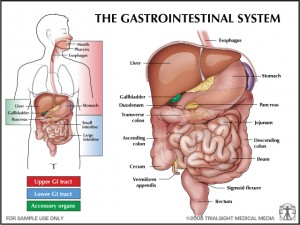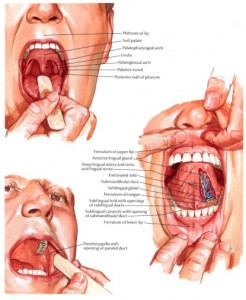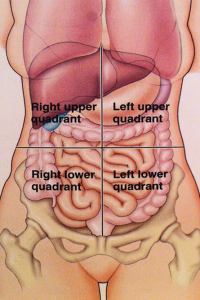Click here to view our short video from youtube– The Crash Course:)
During the assessment of the gastrointestinal system thorough examination of the mouth, abdomen, and rectum should be obtained. The examiner should try and examine the patient in a private, quiet, warm, and well-lit room, explaining the techniques that will be used. First the examiner should start with the mouth. Don gloves before the examination and use inspection and palpitation. Inspect the mouth and jaw for asymmetry and swelling, check the patient’s bite for malocclusion. Inspect inner and outer lips, teeth, gums, and oral mucosa with a penlight. The examiner should note any bleeding, ulcerations, carious, loose, missing, or broken teeth. Next palpate the gums, inner lips, and cheeks for tenderness, lumps, and lesions. Assess the tongue, the examiner should check for coating, tremors, swelling, and ulcerations noting any unusual breath odors. Examine the pharynx by pressing a tongue blade firmly down on the middle of the tongue and ask the patient to say “Ahh.” The examiner should look for uvular deviation, tonsillar abnormalities, lesions, plaque, and exudate (Schilling McCann, 2010).
During examination of the abdomen a sequence is used including inspection, auscultation, percussion, and palpation. Prior to the examine the examiner should ask the patient to empty his/her bladder, place a small pillow under the patient’s knees to help relax the abdominal muscles, ask patient to keep arms at side, keep the room warm, warm hands and stethoscope, and ask the patient to point to any painful areas assessing those areas last. To help with the assessment the examiner should visualize the abdominal structure in four quadrants (Schilling McCann, 2010).
Right upper quadrant includes:
- Right lobe of liver
- Gallbladder
- Pylorus
- Duodenum
- Head of pancreas
- Hepatic flexure of colon
- Portions of ascending and transvers colons
Left upper quadrant includes:
- Left lobe of liver
- Stomach
- Body of pancreas
- Splenic flexure of colon
- Portions of transverse and descending colons
Right lower quadrant includes:
- Portions of ascending colon
Left lower quadrant includes:
- Sigmoid colon
- Portion of descending colon
Inspection of the abdomen should include observation of abdominal symmetry. The examiner should check for bumps, bulges, or masses. Next observe the abdominal shape and contour, the abdomen should be flat to rounded in average weight individuals, slightly concave in slender individuals, and may protrude with obesity, pregnancy, ascites, or abdominal distention. The examiner should then assess the umbilicus which should be inverted and located midline in the abdomen. The skin surrounding the area should be smooth and uniform in color, noting any dilated veins abdominal movement and pulsations (Schilling McCann, 2010).
During auscultation of the abdomen the examiner should lightly place the stethoscope diaphragm in the right lower quadrant, slightly below and to the right of the umbilicus. The examiner should auscultate in a clockwise fashion in each of the four quadrants. Bowel sounds should be high-pitched, gurgling noises caused by air mixing with fluid during peristalsis. Using firm pressure, the examiner should listen with the bell of the stethoscope over the aorta and renal, iliac, and femoral arteries for bruits, venous hums, and friction rubs (Schilling McCann, 2010).
Percussion is used directly or indirectly to detect the size and location of abdominal organs and air or fluid in the abdomen, stomach, or bowel. During direct percussion the examiner should strike their hand or finger directly against the patient’s abdomen. During indirect percussion the examiner should use their middle finger of their dominant hand or a percussion hammer to strike a finger resting on the patient’s abdomen. The examiner should begin percussion in the right lower quadrant and proceed clockwise, covering all four quadrants. During percussion the two sounds that are normally heard include tympany and dullness. Tympany is a clear, hollow sound like a drum beating. This sound is usually heard over hollow organs such as an empty stomach or bowel. Dullness is heard over solid organs, such as the liver, kidneys, or feces-filled intestines (Schilling McCann, 2010).
Palpation helps to determine the size, shape, position, and tenderness of major abdominal organs. It also helps to detect masses and fluid accumulation. The examiner should palpate all four quadrants leaving tender areas for last. Palpate using standard techniques such as putting the fingers of one hand close together, depress the skin about 1.5cm with your fingertips, make gentle, rotating movements, and avoid short, quick jabs. The abdomen should be soft and nontender noting any organs, masses, and areas of tenderness or resistance. The examiner should never palpate a rigid abdomen because peritoneal inflammation may be present. Palpation could cause pain or could rupture in inflamed organ (Schilling McCann, 2010).
Examination of the rectum and anus should be performed in patient’s age 40 or older. The examiner should explain the procedure to the patient. First start with the perianal area, don gloves and spread the buttocks to expose the anus and surrounding tissue. The examiner should check for fissures, lesions, scares, skin tags, inflammation, discharge, rectal prolapse, and external hemorrhoids. Skin in the perianal area is normally somewhat darker than that of the surrounding area. The examiner should then encourage the patient to relax, bear down, and let him/her know that some pressure may be felt as the examiner inserts a finger into the rectum towards the umbilicus. The examiner should rotate finger clockwise and then counterclockwise to palpate as much of the rectal wall as possible. As the examiner removes their finger they should inspect the glove for stool, blood, and mucous. Then test and fecal matter adhering to the glove for occult blood using a guaiac test (Schilling McCann, 2010).
Reference
Schilling McCann, J. A. (2010). Assessment: An incredibly easy! pocket guide. (2 ed., pp. 6-22). Philadelphia, PA: Lippincott Williams & Wilkins and Ovid Technologies, Inc. Retrieved from http://ovidsp.tx.ovid.com.ezaccess.libraries.psu.edu/sp-3.11.0a/ovidweb.cgi?QS2=434f4e1a73d37e8c8b72a1e2ee153b38d445ad17a2480f1bff71a930ce4481914d93429af26d64d70a97f32ebfdb709689c6c63d8f1b47c90bd33427b04aa451f7dfd3c676820ee14094d4655d816a4b0a30f925cf8b251eccf6fbde08f7b0fb8fa1dbe3d887792474ddcbe802901f6537e5f9fe3561e74e506f072d05d312fe1a05eb790fbe746b48d6567244554ea9784830f80626104eafc6bcd6b39697be9689c53d2a082a65e2479e8da3d16bb734f60333b6dc0e4476675cd5860cd2277a62908b8720ca21c2793a64cf7a35d2e53afc4e391ba8732faf5bcf6ec29ae9459a2c23aee123288037faa00a352684344fa6bb77c2532a6bc029c6f7ff88def35e7bc7b905868035284c930b15dc0b0a79d92d2694914e1909ee7780f62c48dc9f513d505d0ba255c549f2e8a03cd354c42363d911ca1c1056bde39c769e0477c31787e490aef2




2 responses to “Assessment of GI”